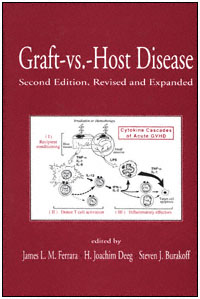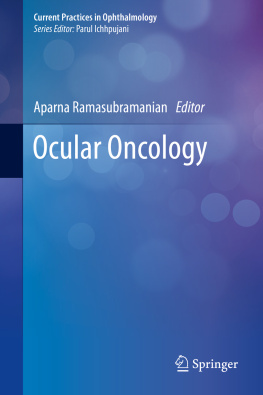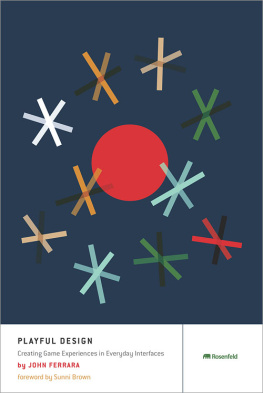James L. M. Ferrara - Graft-vs-Host Disease
Here you can read online James L. M. Ferrara - Graft-vs-Host Disease full text of the book (entire story) in english for free. Download pdf and epub, get meaning, cover and reviews about this ebook. year: 1997, publisher: Marcel Dekker, genre: Home and family. Description of the work, (preface) as well as reviews are available. Best literature library LitArk.com created for fans of good reading and offers a wide selection of genres:
Romance novel
Science fiction
Adventure
Detective
Science
History
Home and family
Prose
Art
Politics
Computer
Non-fiction
Religion
Business
Children
Humor
Choose a favorite category and find really read worthwhile books. Enjoy immersion in the world of imagination, feel the emotions of the characters or learn something new for yourself, make an fascinating discovery.

- Book:Graft-vs-Host Disease
- Author:
- Publisher:Marcel Dekker
- Genre:
- Year:1997
- Rating:3 / 5
- Favourites:Add to favourites
- Your mark:
- 60
- 1
- 2
- 3
- 4
- 5
Graft-vs-Host Disease: summary, description and annotation
We offer to read an annotation, description, summary or preface (depends on what the author of the book "Graft-vs-Host Disease" wrote himself). If you haven't found the necessary information about the book — write in the comments, we will try to find it.
Graft-vs-Host Disease — read online for free the complete book (whole text) full work
Below is the text of the book, divided by pages. System saving the place of the last page read, allows you to conveniently read the book "Graft-vs-Host Disease" online for free, without having to search again every time where you left off. Put a bookmark, and you can go to the page where you finished reading at any time.
Font size:
Interval:
Bookmark:
Cover

| title | : | Graft-vs.-host Disease |
| author | : | Ferrara, James L. M. |
| publisher | : | Informa Healthcare |
| isbn10 | asin | : | 0824797280 |
| print isbn13 | : | 9780824797287 |
| ebook isbn13 | : | 9780585377995 |
| language | : | English |
| subject | Graft versus host disease. | |
| publication date | : | 1997 |
| lcc | : | RD123.5.G73 1996eb |
| ddc | : | 617.4/4 |
| subject | : | Graft versus host disease. |
Page i
Second Edition, Revised and Expanded
edited by
James L. M. Ferrara
Dana-Farber Cancer Institute, Childrens Hospital,
and Harvard Medical School
Boston, Massachusetts
H. Joachim Deeg
Fred Hutchinson Cancer Research Center
and University of Washington
Seattle, Washington
Steven J. Burakoff
Dana-Farber Cancer Institute
and Harvard Medical School
Boston, Massachusetts

Page ii
Library of Congress CataloginginPublication Data
Graftvs.host disease / edited by James L.M. Ferrara, H. Joachim
Deeg, Steven J. Burakoff.2nd ed., rev. and expanded.
p. cm.
Includes index.
ISBN 0824797280 (hardcover: alk. paper)
1. Graft versus host disease. I. Ferrara, James L.M.,
II. Deeg, H. Joachim. III. Burakoff, Steven J.
RD123.5.G73 1996
617.4'4dc20
9631581
CIP
The publisher offers discounts on this book when ordered in bulk quantities. For more information, write to Special Sales/Professional Marketing at the address below.
This book is printed on acid-free paper.
Copyright 1997 by MARCEL DEKKER, INC. All Rights Reserved.
Neither this book nor any part may be reproduced or transmitted in any form or by any means, electronic or mechanical, including photocopying, microfilming, and recording, or by any information storage and retrieval system, without permission in writing from the publisher.
MARCEL DEKKER, INC.
270 Madison Avenue, New York, New York 10016
Current printing (last digit):
10 9 8 7 6 5 4 3
PRINTED IN THE UNITED STATES OF AMERICA
Page iii
The modern era of marrow transplantation spans about three decades. Some patients once thought to have reached the end of the road are now surviving more than 25 years as healthy chimeras, that is, with hematopoiesis and an immune system derived from the graft provided by their marrow donor. However, despite considerable progress in many areas, problems remain. In part, this is related to success: As more and more patients were cured with a marrow transplant from a sibling who was matched with the patient for the major histocompatibility antigens (HLA), attempts were made at expanding the indications for transplantation to patients who did not have an HLA identical sibling. However, with the use of those alternative donors, HLA-nonidentical family members, and unrelated volunteers, problems were encountered. This is particularly true for graft-versus-host disease (GVHD), both in its acute and chronic form. GVHD is of central importance, since it accounts for considerable morbidity, and GVHD and its treatment represent major risk factors for the development of subsequent complications including infection, pulmonary, musculo-skeletal, ocular disease, and other problems.
Nevertheless, advances and gains made even since the publication of the first edition of this book are remarkable. Histocompatibility typing, so essential to the selection of compatible donors, has advanced to the point where single DNA base pair differences at an HLA locus between donor and patient can be identified, and in individual cases have been shown to affect graft outcome. Molecular typing for HLA class II genes has replaced almost completely the mixed leukocyte culture. Gene loci such as HLA-C, which were ignored in the past, have been shown to have an effect on transplant outcome. The same appears to be true for HLA-DQ (DQB1).
The availability of new immunosuppressive agents such as FK506, mycophenolate mofetil, rapamycin, and others has provided more flexibility in the design of GVHD prophylactic regimens. Preliminary results from prospective studies using a
Page iv
combination of FK506 and methotrexate are encouraging. Preclinical studies with combinations of methotrexate and mycophenolate mofetil, or cyclosporine plus rapamycin, suggest that the incidence and severity of GVHD can be further reduced.
T-cell depletion from the donor marrow continues to be explored as an approach to GVHD prevention, but so far has not provided the expected advantages. Recent investigations into the use of selective subset depletion (both CD4 and CD8 depletion has been reported to be beneficial) need to be further expanded before firm conclusions can be drawn. Another potentially exciting development is the infusion of donor lymphocytes that have been genetically marked by a suicide gene. These altered cells are infused to provide their potential graft-enhancing and antileukemic effects. If GVHD develops, however, the patient can be treated with ganciclovir to trigger the suicide mechanism to eliminate the GVHD-inducing cells. A similar approach is being tested in patients who experience a post-transplant relapse. Although the infusion of donor lymphocytes induces remissions in many patients, a frequent complication is the occurrence of GVHD and myelosuppression. If cells are marked by a suicide gene, they can be eliminated by appropriate treatment of the patient. The technology is rapidly evolving to select specific donor cell clones presumably reactive with minor antigens on patient leukemic cells.
Another area that has grown at a rapid pace is the science of cytokines. While the network that governs the interactions of donor and host cells is rather complex, some interventions, e.g., those aimed at TNF-alpha, IL-4, IL-12, and others, may reduce toxicity and enhance the development of tolerance. Considerable work is still required to further characterize the various pathways that may be involved.
Recently, there has been a shift in interest from the use of marrow cells to the use of peripheral blood stem cells, generally after mobilization with cytokines (growth factors). When used in autologous transplantation, these stem cells resulted in extraordinarily fast hematopoietic recovery. With allogeneic transplants, however, there was a concern about the induction of GVHD, in part because of the increased number of T lymphocytes, and in part because of activation of those cells by cytokine mobilization. Surprisingly, early studies in matched sibling transplants have not shown an increase in GVHD despite a log increase in the number of T cells given. Further study is needed to determine whether the benefit (faster engraftment) justifies the potential risk (more GVHD).
Yet another source of hematopoietic stem cells, cord blood cells, has been introduced clinically, particularly for use in pediatric patients. One potential advantage might be a lower incidence of GVHD than seen with marrow cells due to the immaturity of the cells transplanted. Current data are still too limited to predict how this source of stem cells will be used in the future.
Next pageFont size:
Interval:
Bookmark:
Similar books «Graft-vs-Host Disease»
Look at similar books to Graft-vs-Host Disease. We have selected literature similar in name and meaning in the hope of providing readers with more options to find new, interesting, not yet read works.
Discussion, reviews of the book Graft-vs-Host Disease and just readers' own opinions. Leave your comments, write what you think about the work, its meaning or the main characters. Specify what exactly you liked and what you didn't like, and why you think so.









